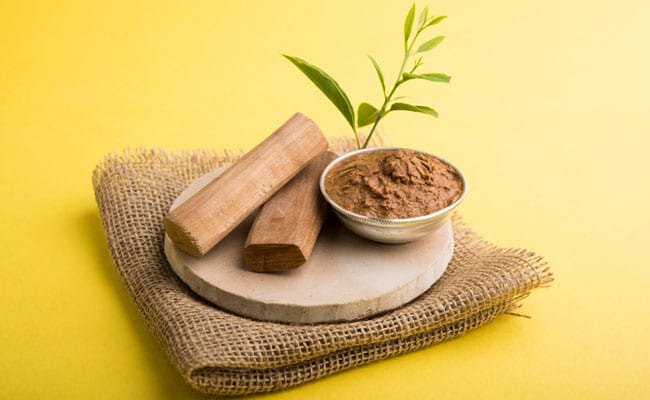
Chandan
- October 28, 2020
- Posted by Dr. Vaidya Karanvir Singh
- 0 Comment(s)
Chandan is considered very sacred in Indian civilization. It also holds high status among many religions and cultures such as Jain, Buddhist, Chinese, Japanese and Korean etc. Its wood is heavy, yellow and fine granulated, which has been known for its fragrance for centuries. These slow growing trees are valuable and in terms of price in the world, it is the second most expensive wood. Sandal wood is mostly used for making incense sticks, aftershaves, perfumes and cosmetics.
Table of Contents
What is Sandalwood?
Sandalwood (chandan) is a herb. It gives people joy due to being fragrant and cool, hence it is called sandalwood. Sandalwood trees are green and 6 to 9 meters high. Its branches are bent. The bark of the sandalwood tree is red (rakta chandan), or brown, or brown-black. Sandalwood leaves are elliptical, soft, and the front part of the leaf is pointed. Sandalwood flowers are purplish, or purple in color, which are odorless. Its fruits are spherical, fleshy, which become ripe, or purple when ripe. Its seeds are hard, elliptical or circular.
Sandalwood trees usually grow only after 20 years. The inner part of the tree is light yellow in color, and fragrant. The bark of old trees (chandan tree) is cracked. Sandalwood tree after 40-60 years of age becomes of good aroma. The flowers in the sandalwood tree are from June to September, and the fruits from November to February. In such a situation sandalwood becomes fully usable. Some features of the sandalwood tree are:
Sandalwood is best in Odisha.
Sandalwood occurring in places like western Uttar Pradesh etc. is said to be of the lowest quality.
Odisha sandalwood is best by smell
Chandan in Different Languages
The botanical name of sandalwood is Santalum album Linn, and is of the Santalaceae clan. There are other names, which are popular: –
Chandan in –
- Hindi- sandalwood, white sandalwood, white sandalwood
- Urdu-Sandal Safed
- English- Sandal tree, White sandal tree, True sandal wood, Sandal wood
- Sanskrit- Shrikhand, Chandan, Bhadrasri, Telparnik, Gandhasar, Malayas, Chandradyuti
- Kannada-Shrigandha
- Gujarati-Sukhud
- Telugu-Gandhapu chekka, Chandnamu
- Tamil- Chandanam maram, Sandanam, Ulosidam
- Bengali-Chandan
- Marathi-Chandan, Gandhchakoda
Ayurvedic properties
Rasa-Madhur, Tikta
Guna-Laghu, Ruksha
Virya-Sheet
Vipaka-Katu
Classical categorization
By aacharya Charak- angamarda prashaman, varnya, kandu
Chandan Benefits
This miraculous wood is a storehouse of benefits: –
Provide mental relaxation
The effect of sandal wood is calm and relaxing. Because of its calming effect, it is used during prayer, meditation or other spiritual activities. When it is applied or smelled on the skin it creates a feeling of peace and harmony.
Improve memory
It promotes concentration, calms the mind and also reduces stress and anxiety.
Aphrodisiac properties
It naturally enhances libido in men as well as provides energy.
Anti-inflammatory
Sandal wood has an active ingredient called Santol which provides relief from insect bites, irritation and other skin conditions.
Anti-viral and anti-septic
Sandal has amazing effects on common cold, fever, cough and other viral infections. If taken safely with milk, it cures infections related to throat, food pipe, stomach, intestines and excreta.
Diuretic and abdominal cramps
It relaxes the inflammation in the urinary system, clears the way of urination and removes toxic substances from the body. It helps to release the gas from the stomach and relaxes the stomach muscles. Its calming nature provides relief from cramps and contractions.
Reduce blood pressure
If applied directly to the skin, it reduces blood pressure.
Germicide
Using it while washing clothes or cleaning the house keeps germs away and infection defects are removed.

Dr. Vaidya Karanvir Singh is the younger Vaidya in Chandigarh Ayurved & Panchakarma Centre. He is the fourth generation in his family who is practicing as a general consultant in Ayurved & Panchakarma treatment at Chandigarh. In his practice, he had treated more than 1 Lakh Plus patients worldwide.

